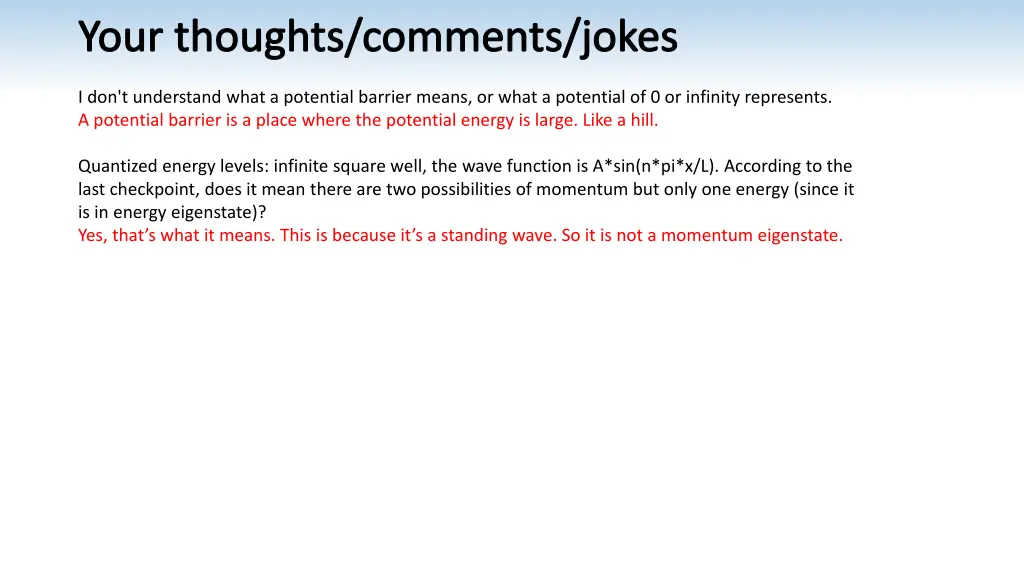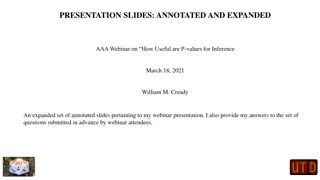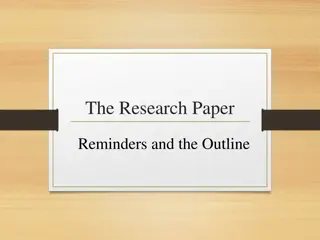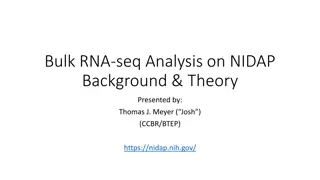
Understanding Quantum Mechanics: Energy States and Eigenvalues
Delve into the concepts of potential barriers, energy eigenstates, and momentum eigenstates in quantum mechanics. Explore how the Schrödinger equation defines the behavior of particles in different scenarios.
Download Presentation

Please find below an Image/Link to download the presentation.
The content on the website is provided AS IS for your information and personal use only. It may not be sold, licensed, or shared on other websites without obtaining consent from the author. If you encounter any issues during the download, it is possible that the publisher has removed the file from their server.
You are allowed to download the files provided on this website for personal or commercial use, subject to the condition that they are used lawfully. All files are the property of their respective owners.
The content on the website is provided AS IS for your information and personal use only. It may not be sold, licensed, or shared on other websites without obtaining consent from the author.
E N D
Presentation Transcript
Your thoughts/comments/jokes I don't understand what a potential barrier means, or what a potential of 0 or infinity represents. A potential barrier is a place where the potential energy is large. Like a hill. Quantized energy levels: infinite square well, the wave function is A*sin(n*pi*x/L). According to the last checkpoint, does it mean there are two possibilities of momentum but only one energy (since it is in energy eigenstate)? Yes, that s what it means. This is because it s a standing wave. So it is not a momentum eigenstate.
Lecture 8: Time independent Schr dinger equation 2 2? ?2 (?) ??2 + ? ? x = E (?) Wave functions for which this is true are energy eigenstates. We will measure energy E with probability 1.
An equation for momentum eigenstates ? ? ? = ? (?) ?? In general, If you have a linear transformation T, an eigenstate of this transformation will satisfy the following relation: ?? = ?? Where ? is the eigenvalue and ? is the eigenvector/eigenstate
?2 2?for a free particle 2 2? Consistent with ? = ?2 (?) ??2 = E (?) ? = ????? ? = ? Is this consistent? Expect ? =?2 2?= 2?2 2? Wave functions with definite momentum have definite energy if there is no potential energy term (free particles).
The Schrdinger equation 2 2? ?2 (?) ??2 + ? ? x = E (?) Wave functions that satisfy this are called energy eigenstates; they have definite energy. Wave functions that satisfy this equation are also stationary; the probability does not change with time. When a particle is confined, there are discrete energy eigenstates. It cannot take on all energies.
Checkpoint Suppose that the wave function of an electron in an atom DOES NOT satisfy the time- independent Schr dinger equation; that is, 2 2? ??2 ?2 (?) + ? ? x E (?) Which of these statements is true? a) This is not possible; wave functions must always satisfy the time-independent Schroedinger equation. b) The wave function is an energy eigenstate. c) When the energy is measured, several different values have non-zero probability.
Infinite square well ? Infinity 0 ? Infinity
Why is it called a square well? Infinite square well 2 2? ?2 (?) ??2 + ? ? x = E (?) ? 0 Infinity Infinity ? In the regions where ? is infinite, what should be to satisfy the S.E.? a) ??? b) sin(??) c) 1 d) 0
Infinite square well 2 2? ?2 (?) ??2 + ? ? x = E (?) ? 0 Infinity Infinity ? L 0 In the regions where ? is 0, what should be to satisfy the S.E.? a) ??? b) sin(??) c) 1 d) 0
Boundary conditions 2 2? ?2 (?) ??2 + ? ? x = E (?) To have a continuous function: ? ? =n ? 0 Infinity Infinity ? 0 = 0 L = 0 x = sin(??)
Normalization ? = ? sin(??) for 0 < ? < ? and 0 otherwise ? =n ? What should C be to ensure that the particle is in the box with probability 1? 2 ? ? =
Discrete spectrum ?3=9 2?2 2 2? ?2 n(?) ??2 2??2 + ? ? nx = E n(?) 2 ? sin(??? ?? = ?) for 0 < ? < ? and 0 otherwise ?2=4 2?2 ??=?2 2?2 2??2 2??2 If we measure the energy, then we will only find an allowed value of E. ?1= 2?2 The electron can only emit/absorb photons with energy equal to the difference between allowed energies. 2??2
Photon absorption A hydrogen atom has an electron starting in its ground state. What photons can be absorbed, leaving the electron in an excited state? E3 a) ? = ?1 b) ? = ?2 ?1 c) ? = ?3 ?2 d) Any photon can be absorbed. Photon, energy hf E2 Electron E1
Photon emission A hydrogen atom has an electron starting in its excited state. What photons can be emitted, leaving the electron in the ground state? Electron E3 a) ? = ?3 b) ? = ?2 ?1 c) ? = ?3 ?1 d) Any photon can be emitted. E2 E1
Energies of the infinite square well An electron is in an infinite square well. Starting in the ground state, the longest wavelength that it can absorb is ?. What equation can we solve for ?? (Remember, = 2? ) ? ?=4 2?2 2?2 2??2(32 12) 2?2 2??2(22 12) a) b) ? c) ? 2??2 ?= ?=
The first few eigenstates A ?? = ? sin(?? ?) for 0 < ? < ? and 0 otherwise ??=?2 2 2??2 B If the ground state (lowest energy) has energy E1, then which state has energy 4E1? a) b) c) C
The first few eigenstates A ?? = ? sin(?? ?) for 0 < ? < ? and 0 otherwise ??=?2 2 2??2 B Which state has the least chance of being found right in the middle of the well? a) b) c) C
Vocabulary State: The state is given by the wave function. Complete description of the physical properties. Eigenstate: State that satisfies the time-independent Schr dinger equation Ground state: Eigenstate with the lowest energy. Excited state: Eigenstate with a higher energy than the ground state. Quantum number: Since the particle can only take on discrete energies, states and energies are labeled by a number (n for the infinite square well)
Summary 2 2? ?2 (?) ??2 + ? ? x = E (?) ? Wave functions that satisfy this are called energy eigenstates; they have definite energy. 0 Infinity Infinity Wave functions that satisfy this equation are also stationary; the probability does not change with time. We will show that these states are stationary next week. 2 ? sin(??1? ?? = ?) for 0 < ? < ? and 0 otherwise ??=?2 2?2 2??2 When a particle is confined, there are discrete energy eigenstates. It cannot take on all energies.






















